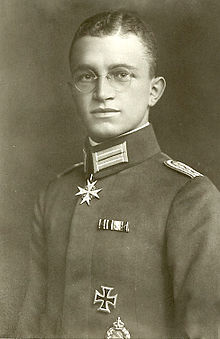Kurt Wintgens
| Kurt Wintgens | |
|---|---|
 |
|
| Born | 1 August 1894 Neustadt, German Empire (now Prudnik, Poland) |
| Died | 25 September 1916 (aged 22) Villers-Carbonnel, France |
| Allegiance | German Empire |
| Service/branch | Signal Corps, Aviation, Luftstreitkräfte |
| Years of service | 1913–1916 |
| Rank | Leutnant |
| Awards | Iron Cross, Pour le Merite |
Leutnant Kurt Wintgens (1 August 1894 – 25 September 1916) was a German World War I fighter ace. He was the first military fighter pilot to score a victory over an opposing aircraft, while piloting an aircraft armed with a synchronized machine gun. Wintgens was the recipient of the Iron Cross and the Pour le Mérite.
Wintgens was born into a military family in Neustadt in Oberschlesien (today's Prudnik in Poland). His military service commenced when he joined the Telegraphen-Bataillon Nr. 2 in Frankfurt/Oder as a Fahnenjunker (cadet officer) in 1913.
Though still in military school when the war began in 1914, Wintgens was sent to the Eastern Front as a leutnant and won the Iron Cross, 2nd Class. On transferring to the German Air Service, Wintgens flew first as an observer, apparently alternating with telegraph duty. However, in early 1915 he entered pilot training at the Fokker school in Schwerin, where Leutnant Otto Parschau had already been brought in by the Fokker factory to prepare an example of an armed (with a Parabellum MG14 synchronized gun) version of the Fokker A.III single-seat monoplane, with IdFlieg military serial number A.16/15 (the very same "green machine" aircraft that Parschau had flown since the summer of 1914) for front-line trials. Wintgens specifically requested the chance "to fly in the field the smallest and fastest Fokker type with the Garros-installation, which enabled a built-in machine gun to fire through the propeller." With that background he was selected, along with Leutnant Parschau, as one of the first Fokker Eindecker pilots, flying single-seaters that had been assigned to fly alone with various two-seater-equipped field flying detachments, starting with the Bavarian Feldflieger Abteilung 6b, then based near Saarburg.
...
Wikipedia
